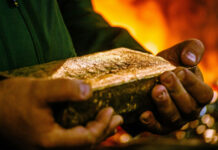
[miningmx.com] — THIS year could prove more difficult for our miners than first imagined. Sure, commodity prices are decidedly unhelpful, but the compensating decline in input prices, such as steel for instance, may not provide the much-needed fillip owing to certain exogenous factors.
Here’s what I mean. From May, mining companies will have to provide for the impact of royalties. These are royalties that must be paid as compensation to the citizens of South Africa for the loss of their mineral patrimony. Known in its draft form as the Royalty Bill, the legislation aims to funnel some of the profits from mining into the fiscus partly for redevelopment of areas that were founded on a mining ticket but have now lost their economy as mining ends.
While in theory, the legislation makes eminent sense – after all, once the minerals are gone, they’re gone forever – it will hit the industry hard in the 2009/2010 financial year. Frank Abbott, the financial director of Harmony Gold, says the royalty is at the earnings before interest and tax (Ebit) level and rises and falls with profit-making. That’s definitely a bonus considering the first few iterations of the Royalty Bill set down a revenue-based levy.
Nonetheless, I would have thought miners would be chary of losing any profit they’re making at the moment not forgetting corporate tax.
Perhaps more disturbing at the moment, however, is the condition of relations between unions and mining companies. A stand-out development of last week’s December gold quarterlies was the anger of DRDGold boss Niel Pretorius who scolded regional representatives of NUM.
He felt internal politicking among NUM members was behind calls by the union to have DRDGold’s Blyvoor mine shut after some 167 miners had been trapped underground. But the reason they were trapped was the force majeure event of a lightning strike which disabled Blyvoor’s power units.
Safety consciousness is so (rightly) high among government’s minerals and energy department (DME) that it dispatches a safety officer immediately to any mine where safety has been compromised. According to Pretorius, the DME’s safety man was heavily prevailed upon by NUM members to shut Blyvoor even though the mine was faultless.
You don’t shut and open mines like a tap. It’s a highly disruptive process and translates into lost revenue. Like I say, miners could do without any disruptions.
Not a one-off
After Pretorius’ outburst, one analyst told me these problems were actually widespread throughout the industry lately. For example, Harmony Gold and Lonmin have been dealing with increasingly trenchant union activity. In the case of Harmony Gold, it has been faced with a spate of underground fires at its Bambanani mine as unions battle their own underground war.
Why unions are suddenly more irascible is a moot point.
Certainly, the new government has given extra leash to Cosatu. With a new president and a fresh emphasis on delivery, the heavily politicised NUM will have its work cut out keeping its members reasonable and level-headed. But there’s another red flag here. Don’t the mining industry’s two-year wage talks start this year, roughly a month after the general election?
Harmony’s Graham Briggs says that’s how the cookie crumbles; in any event, wage talks this year will be dominated by job preservation – which sounds ominious for the unions. But I wondered – in Pretorius’ case – whether he risks riling NUM at a time when he could least afford it. I don’t think his public outburst did him any favours.
All in all, I think the increase in the political temperature this year sounds ominous for the South African mining industry in general.
One final footnote to this particular issue was suggested to me by a certain mining CEO whom I won’t name, for obvious reasons. He thinks pressurising bosses and making them look like fools is a precursor to calls to nationalise the industry.
I also noticed one recommendation in the presidential safety audit that mining companies ought to invest in more infrastructure. This is the study initiated by former president Thabo Mbeki after more than three thousand miners were trapped – some for 38 hours – at Harmony?s Elandsrand mine in October 2007.
The study took a year to complete and now finds that our mines are only 66% safe. I don’t know if government will be able to press home increased spending on safety-related infrastructure but any mine bearing just over a 50% chance of providing a safe environment for its workers will have to be highly persuasive on why it shouldn’t spend more on safety.
Doornkop mine
It’s been quite a while since I was last underground. I must have been fitter the last time because crawling around the one metre stope face of Harmony’s Doornkop mine, near Randfontein, last week left me exhausted, and reminded me of how difficult the actual activity of mining really is.
The stope is, quite simply, “the coal face”; where the gold-bearing ore is blasted and scraped into hoppers for surface. It’s hot – you are soaked through – cramped and noisy. The guys with the drills are the best paid underground barring their managers and, according to Doornkop management, share a unique culture of derring-do and camaraderie that makes multi-tasking virtually impossible underground.
Doornkop is going to produce 500 000 ounces/year for Harmony from 2013 so it’s quite a big deal. I mention this because I was struck with how the mine has made safety a key condition to working there.
This is where it becomes very, very difficult for the miners, however. Thousands upon thousands of safe manhours can be wiped out with a single mistake or unforseen seismic activity. South Africa’s mining safety stats are improving year-on-year, so while you can’t put a value on a human life, I hope government also doesn’t lose perspective of the efforts made.











